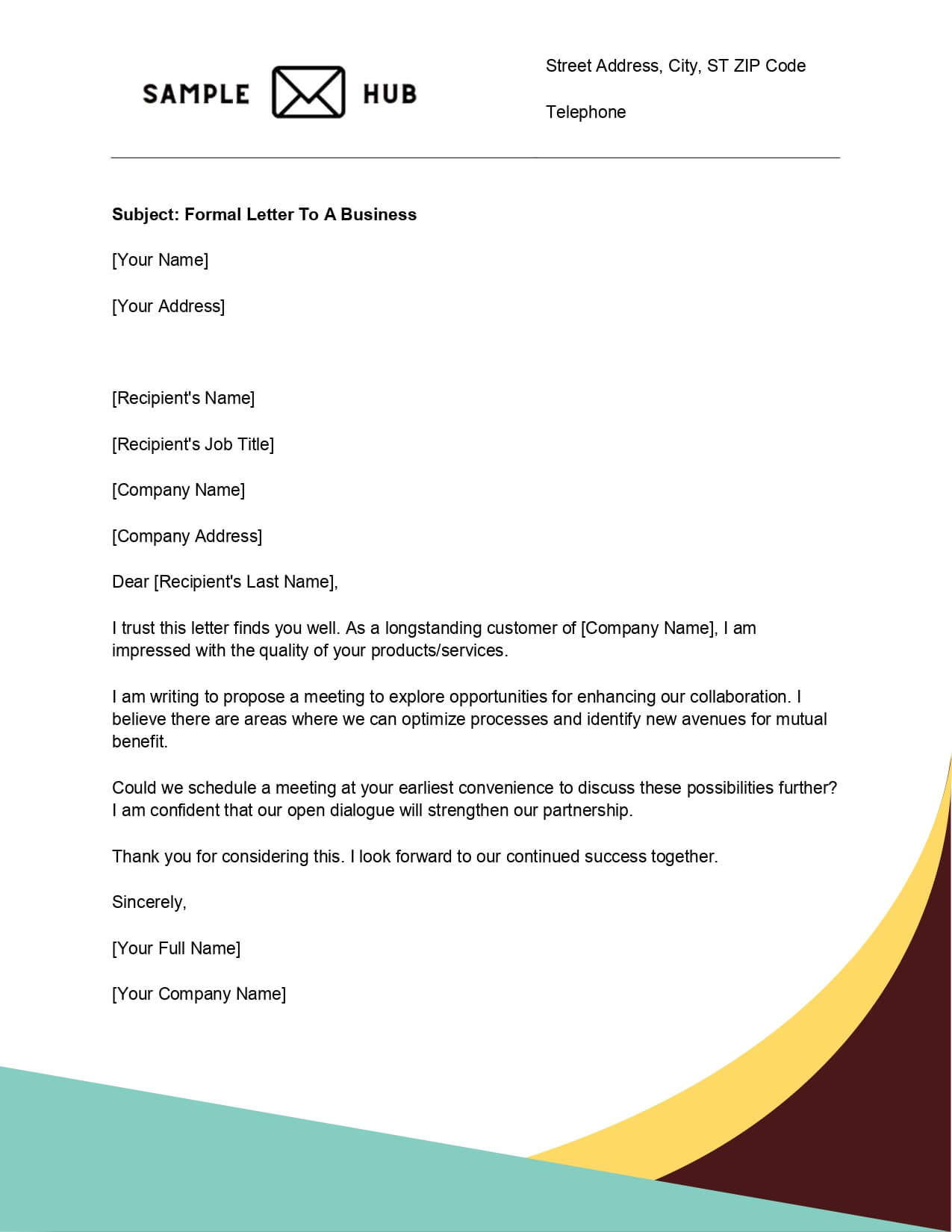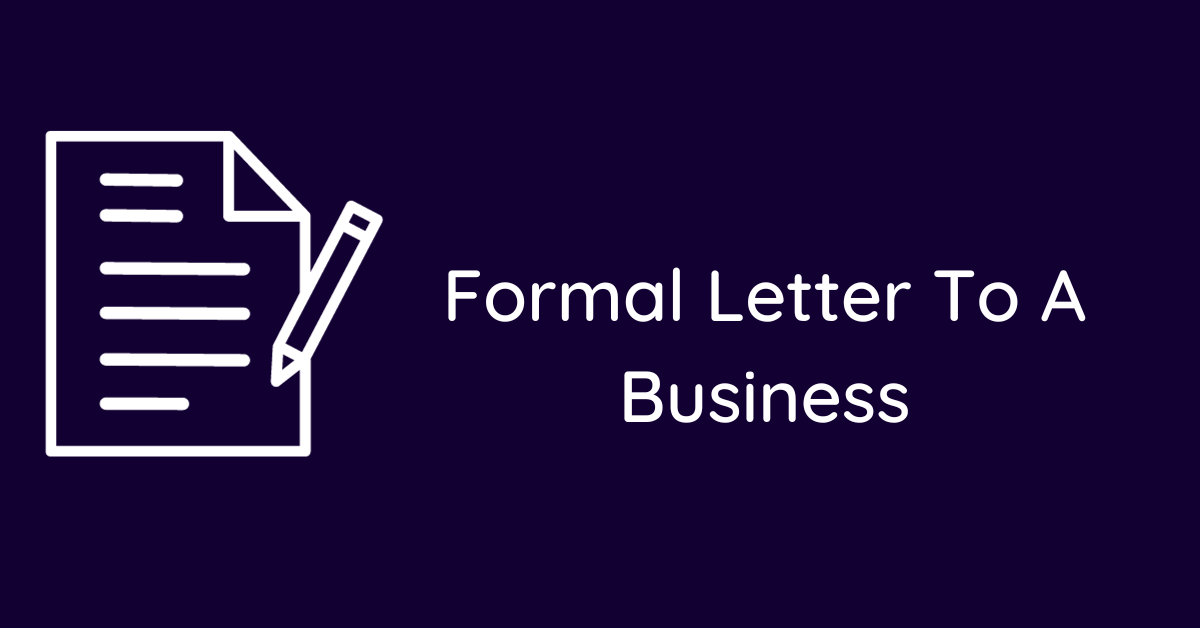Are you struggling to write a formal letter to a business? Don’t worry, we’ve got you covered! In this article, we will provide you with templates, examples, and samples of formal letters to businesses.
A formal letter to a business is a professional way of communicating with a company or organization. It is usually written to request information, make a complaint, or express appreciation.
The purpose of a formal letter is to convey a message in a clear and concise manner, while maintaining a professional tone.
We understand that writing a formal letter can be daunting, especially if you’re not sure where to start.
That’s why we have compiled a list of templates and examples to help you write a letter that is both effective and professional.
Whether you’re writing to a potential employer, a supplier, or a customer, our samples will provide you with the guidance you need to write a successful letter.
Formal Letter To A Business
Dear [Recipient’s Last Name],
I hope this letter finds you well. I am writing to you on behalf of [Your Company Name], and I extend my warm greetings to [Business Name].
[Brief introduction about your company and its purpose for contacting the recipient’s business. Include any relevant details about your company’s background, products, or services.]
We have been following the success of [Business Name] and are impressed by [specific aspects or achievements]. As we share common values of [shared values], I believe there could be potential collaboration opportunities between our two businesses.
[Specify the purpose of the collaboration or any specific proposal you have in mind. Highlight the mutual benefits and how it aligns with both companies’ goals.]
We would be honored to discuss this further with you at your earliest convenience. Please let us know a suitable time for a meeting, or if you prefer, we can arrange a call to explore the possibilities of working together.
Thank you for considering this proposal. We look forward to the opportunity of building a successful partnership between [Your Company Name] and [Business Name].
Sincerely,
[Your Full Name]
Professional Business Letter
Dear [Recipient’s Last Name],
I trust this letter finds you well. My name is [Your Full Name], and I am writing to you in my capacity as [Your Position] at [Your Company Name].
[Brief introduction about the purpose of the letter and the reason for contacting the recipient. Mention any relevant details about your company and its relation to the recipient’s business.]
[Provide detailed information or request as needed. Be clear and concise in your communication, ensuring that the recipient can easily understand the purpose of the letter and any necessary actions to be taken.]
I appreciate your prompt attention to this matter. If you have any questions or require further clarification, please do not hesitate to contact me at [Your Contact Number] or [Your Email Address].
Thank you for your time and consideration. I look forward to the possibility of [desired outcome] and the opportunity to strengthen our professional relationship.
Sincerely,
[Your Full Name]
Standard Business Letter Format
Dear [Recipient’s Last Name],
I hope this letter finds you well. My name is [Your Full Name], and I am writing to you on behalf of [Your Company Name].
[Brief introduction about the purpose of the letter and the reason for contacting the recipient. Mention any relevant details about your company and its relation to the recipient’s business.]
[Provide detailed information or request as needed. Be clear and concise in your communication, ensuring that the recipient can easily understand the purpose of the letter and any necessary actions to be taken.]
I appreciate your prompt attention to this matter. If you have any questions or require further clarification, please do not hesitate to contact me at [Your Contact Number] or [Your Email Address].
Thank you for your time and consideration. I look forward to the possibility of [desired outcome] and the opportunity to strengthen our professional relationship.
Sincerely,
[Your Full Name]
Proper Format For A Business Letter
Dear [Recipient’s Last Name],
I trust this letter finds you in good health. My name is [Your Full Name], and I am reaching out to you on behalf of [Your Company Name].
[Provide a brief introduction about the purpose of the letter and the context for contacting the recipient. Include any relevant details about your company and its relation to the recipient’s business.]
[Offer detailed information or make a request as necessary. Ensure clarity in your communication, so the recipient understands the purpose of the letter and any required actions.]
Your prompt attention to this matter is highly appreciated. Should you have any queries or require further clarification, please feel free to contact me at [Your Contact Number] or [Your Email Address].
Thank you for dedicating time to this correspondence. I look forward to the potential of [desired outcome] and the prospect of fortifying our professional association.
Best Regards,
[Your Full Name]
Correct Business Letter Format
Dear [Recipient’s Last Name],
I hope this letter finds you well. My name is [Your Full Name], and I am writing to you on behalf of [Your Company Name].
[Provide a brief introduction about the purpose of the letter and the context for contacting the recipient. Include any relevant details about your company and its relation to the recipient’s business.]
[Offer detailed information or make a request as necessary. Ensure clarity in your communication, so the recipient understands the purpose of the letter and any required actions.]
I appreciate your prompt attention to this matter. If you have any questions or require further clarification, please do not hesitate to contact me at [Your Contact Number] or [Your Email Address].
Thank you for your time and consideration. I look forward to the possibility of [desired outcome] and the opportunity to strengthen our professional relationship.
Sincerely,
[Your Full Name]

How to Write a Formal Letter to a Business
Writing a formal letter to a business can be a daunting task, especially if you are not familiar with the format and tone of such letters. However, with a little bit of guidance and practice, you can master the art of writing a formal letter to a business.
In this article, we will guide you through the process of writing a formal letter to a business in seven easy steps.
Step 1: Identify the Purpose of Your Letter
Before you start writing your letter, you need to identify the purpose of your letter. Are you writing to inquire about a product or service? Are you writing to make a complaint? Are you writing to request information? Once you have identified the purpose of your letter, you can proceed to the next step.
Step 2: Choose the Right Format
The format of your letter will depend on the purpose of your letter. If you are writing to inquire about a product or service, you can use a standard business letter format. If you are writing to make a complaint, you may want to use a more formal format. If you are writing to request information, you may want to use a more informal format.
Step 3: Address the Recipient
When addressing the recipient of your letter, it is important to use the correct title and name. If you are unsure of the recipient’s name, you can use a generic title such as “”Dear Sir/Madam”” or “”To Whom It May Concern.””
Step 4: Introduce Yourself
In the opening paragraph of your letter, you should introduce yourself and explain the purpose of your letter. Be clear and concise in your introduction, and avoid using overly formal language.
Step 5: Provide Details
In the body of your letter, you should provide details about your inquiry, complaint, or request. Be specific and provide as much information as possible. Use bullet points or numbered lists to make your letter easier to read.
Step 6: Close Your Letter
In the closing paragraph of your letter, you should thank the recipient for their time and consideration. You may also want to include a call to action, such as requesting a response or asking for a meeting.
Step 7: Proofread Your Letter
Before sending your letter, it is important to proofread it for spelling and grammar errors. You may also want to have someone else read your letter to ensure that it is clear and concise.
FAQs About Formal Letter to a Business
1. What is a formal letter to a business?
A formal letter to a business is a written communication that follows a specific format and tone. It is usually used to convey important information, make a request, or express a concern to a business or organization.
2. What should be included in a formal letter to a business?
A formal letter to a business should include the sender’s contact information, the date, the recipient’s contact information, a formal greeting, the body of the letter, a formal closing, and the sender’s signature.
3. How should I address the recipient in a formal letter to a business?
The recipient of a formal letter to a business should be addressed using their formal title and last name. For example, “”Dear Mr. Smith”” or “”Dear Dr. Johnson.””
4. What is the appropriate tone for a formal letter to a business?
The appropriate tone for a formal letter to a business is professional and respectful. Avoid using slang or informal language, and keep the tone formal throughout the letter.
5. How should I format a formal letter to a business?
A formal letter to a business should be formatted using a standard business letter format. This includes a left-aligned heading, a block-style body, and a formal closing.
6. What should I do if I don’t receive a response to my formal letter to a business?
If you don’t receive a response to your formal letter to a business, you may want to follow up with a phone call or email. Be polite and professional in your follow-up communication.
7. Can I send a formal letter to a business via email?
Yes, you can send a formal letter to a business via email. However, make sure to follow the same formatting and tone guidelines as you would for a printed letter.
Related:
- Letter To The Bride Book ( 5 Samples )
- Authorization Letter To Bank ( 5 Samples )
- Day care Welcome Letter To Parents ( 5 Samples )
- Letter Of Appeal To Insurance ( 5 Samples )
- Letter To Remove Credit Inquiries (5 Samples)

